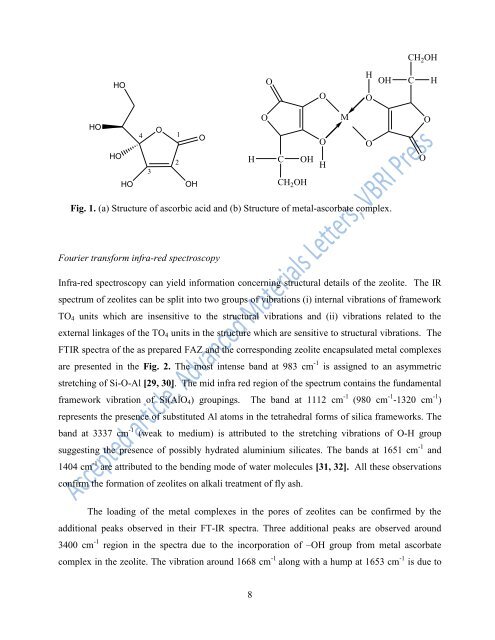Synthesis, characterization and catalytic activity of transition metal ...
Synthesis, characterization and catalytic activity of transition metal ...
Synthesis, characterization and catalytic activity of transition metal ...
Create successful ePaper yourself
Turn your PDF publications into a flip-book with our unique Google optimized e-Paper software.
HO<br />
HO<br />
HO<br />
HO<br />
4<br />
3<br />
O<br />
1<br />
2<br />
OH<br />
O<br />
H<br />
8<br />
O<br />
O<br />
C OH<br />
CH 2OH<br />
Fig. 1. (a) Structure <strong>of</strong> ascorbic acid <strong>and</strong> (b) Structure <strong>of</strong> <strong>metal</strong>-ascorbate complex.<br />
Fourier transform infra-red spectroscopy<br />
O<br />
O<br />
H<br />
M<br />
H<br />
O<br />
O<br />
OH<br />
CH 2OH<br />
C H<br />
Infra-red spectroscopy can yield information concerning structural details <strong>of</strong> the zeolite. The IR<br />
spectrum <strong>of</strong> zeolites can be split into two groups <strong>of</strong> vibrations (i) internal vibrations <strong>of</strong> framework<br />
TO4 units which are insensitive to the structural vibrations <strong>and</strong> (ii) vibrations related to the<br />
external linkages <strong>of</strong> the TO4 units in the structure which are sensitive to structural vibrations. The<br />
FTIR spectra <strong>of</strong> the as prepared FAZ <strong>and</strong> the corresponding zeolite encapsulated <strong>metal</strong> complexes<br />
are presented in the Fig. 2. The most intense b<strong>and</strong> at 983 cm -1 is assigned to an asymmetric<br />
stretching <strong>of</strong> Si-O-Al [29, 30]. The mid infra red region <strong>of</strong> the spectrum contains the fundamental<br />
framework vibration <strong>of</strong> Si(AlO4) groupings. The b<strong>and</strong> at 1112 cm -1 (980 cm -1 -1320 cm -1 )<br />
represents the presence <strong>of</strong> substituted Al atoms in the tetrahedral forms <strong>of</strong> silica frameworks. The<br />
b<strong>and</strong> at 3337 cm -1 (weak to medium) is attributed to the stretching vibrations <strong>of</strong> O-H group<br />
suggesting the presence <strong>of</strong> possibly hydrated aluminium silicates. The b<strong>and</strong>s at 1651 cm -1 <strong>and</strong><br />
1404 cm -1 are attributed to the bending mode <strong>of</strong> water molecules [31, 32]. All these observations<br />
confirm the formation <strong>of</strong> zeolites on alkali treatment <strong>of</strong> fly ash.<br />
The loading <strong>of</strong> the <strong>metal</strong> complexes in the pores <strong>of</strong> zeolites can be confirmed by the<br />
additional peaks observed in their FT-IR spectra. Three additional peaks are observed around<br />
3400 cm -1 region in the spectra due to the incorporation <strong>of</strong> –OH group from <strong>metal</strong> ascorbate<br />
complex in the zeolite. The vibration around 1668 cm -1 along with a hump at 1653 cm -1 is due to<br />
O<br />
O
















